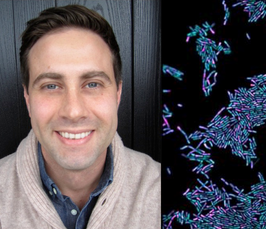The ParA/MinD family of ATPases make waves to position DNA, Cell Division, & Organelles in bacteria
Special seminar
- Datum: 05.04.2019
- Uhrzeit: 13:15
- Vortragende(r): Dr. Anthony Vecchiarelli
- Assistant Professor, University of Michigan, Department of Molecular, Cellular, and Developmental Biology (MCDB)
- Ort: MPI for Terrestrial Microbiology
- Raum: Lecture hall
- Gastgeber: Dr. Simon Ringgaard
- Kontakt: simon.ringgaard@mpi-marburg.mpg.de

Positional information in eukaryotic cells is mainly orchestrated by cytoskeletal highways and their associated motor proteins like Myosin, Kinesin, and Dynein. Bacteria don't have linear motors, so how do they spatially organize the cell? I will be discussing three members of the ParA/MinD family of ATPases that are part of self-organizing systems that put things in their place in cells across the microbial world. I will first present the ATPase called ParA, which is part of the most common DNA-segregation system in bacteria. ParA proteins form dynamic waves on the nucleoid to position chromosomes and plasmids in opposite cell-halves so that they are faithfully inherited after cell division. I will then discuss the ATPase called MinD, which is part of the a system that forms oscillatory waves on the inner membrane. The oscillation aligns cell division at mid-cell so that daughter cells are equal in size. Finally, I will introduce a new member of this ATPase family we call McdA, which is part of a trafficking system for bacterial microcompartments, specifically the carboxysome. Our work is shedding light on what seems to be a general mode of subcellular organization in bacteria - dynamic protein gradients surfing biological surfaces to impart positional information for a wide variety of fundamental biological processes.